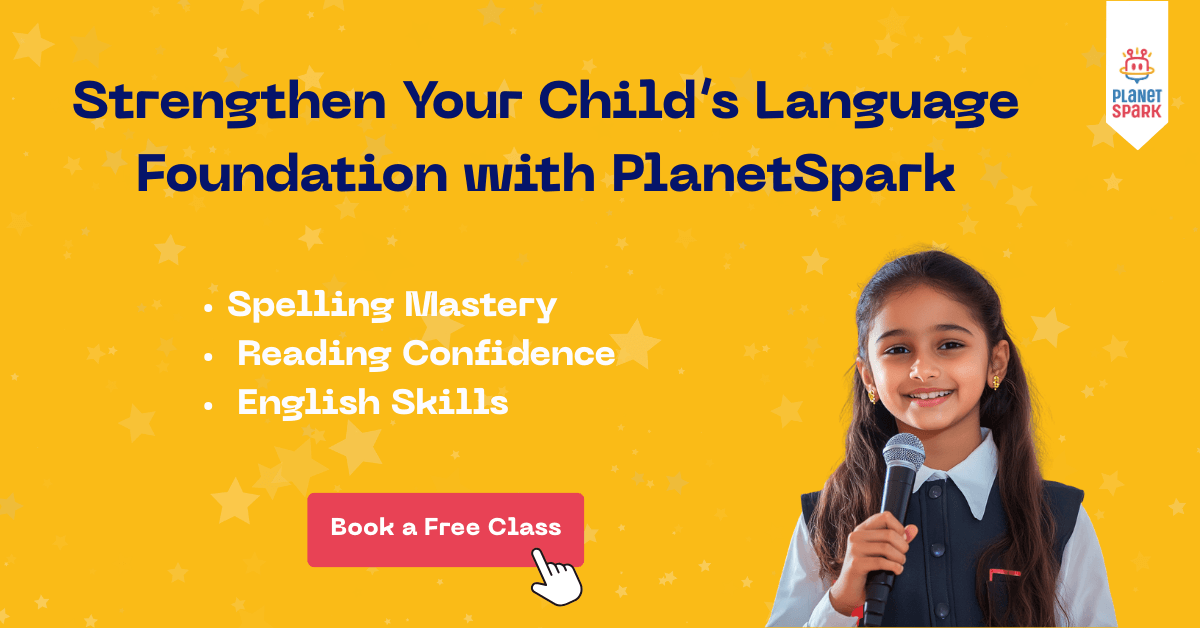Importance of Spelling and How Spelling Supports Reading

Table of Contents
- Why Spelling Is Important for Children
- How Spelling Supports Reading
- Practical Ways to Improve Spelling and Reading Together
- How Spelling Strengthens Vocabulary and Comprehension
- Role of Spelling in Everyday Life
- Common Challenges Children Face in Spelling and Reading
- Why Choose PlanetSpark for English Learning
- Conclusion
- Readers Also Read
- FAQs
Spelling may look like a simple skill, but it is actually the foundation of strong reading and writing abilities. Children who spell well can decode words faster, understand texts better, and express themselves more clearly. In fact, the importance of spelling goes far beyond memorising word lists, it’s about understanding how letters and sounds connect to form meaning.
When kids master spelling, they gain more than accuracy in writing. They develop confidence, fluency, and a lifelong love for reading. Let us explore why spelling is important and how it directly supports reading development.
Why Spelling Is Important for Children
Spelling is more than just memorising letters, it is a foundation for reading, writing, and communication. When children develop strong spelling skills, they unlock the ability to express themselves with clarity and confidence. Let’s look at why spelling is so important for children, with practical examples.
1. Builds Stronger Reading Skills
Spelling and reading go hand in hand. When children understand how words are spelled, they start noticing patterns in text. This pattern recognition makes reading smoother and faster.
Example:
If a child learns the spelling of light, they can easily decode similar words like bright, night, and sight because they share the “-ight” pattern. This connection helps them read new words independently without constant guidance.
2. Improves Writing Fluency
Children who struggle with spelling often pause while writing, which breaks their flow of ideas. Strong spelling skills allow them to write quickly and fluently, focusing more on their creativity than on whether a word is correct.
Example:
A child writing a story about a trip to the zoo will write with more confidence if they already know how to spell words like elephant, monkey, and giraffe. Instead of getting stuck, they can focus on building an engaging story.
3. Expands Vocabulary
Every spelling lesson introduces children to new words, pronunciations, and meanings. By learning the correct spellings, children naturally expand their vocabulary and develop a stronger command of language.
Example:
When children learn the difference between there, their, and they’re, they not only improve spelling but also gain clarity about how these words are used in different contexts. This strengthens both vocabulary and grammar.
4. Boosts Confidence and Communication
Correct spelling gives children confidence in both written and spoken communication. They feel proud of their abilities and are more willing to participate in class discussions, read aloud, and share their writing.
Example:
A child who spells successfully without hesitation will read it aloud in front of classmates with confidence. This pride motivates them to keep improving and to view reading and writing as enjoyable activities.
5. Prepares for Academic Success
Spelling is essential for exams, essays, and even competitive tests. Incorrect spelling can reduce marks, even if the content is strong. Developing spelling skills early helps children perform better academically and sets them up for future success.
Example:
In a school exam, if a student writes freind instead of friend, marks may be deducted. Over time, correct spelling ensures children present their knowledge accurately, leading to higher scores and stronger communication skills.
How Spelling Supports Reading
When we discuss the importance of spelling, we must also see how it supports reading development. A child who understands spelling patterns finds it easier to decode, pronounce, and comprehend words. This makes reading smoother, more meaningful, and enjoyable.
1. Recognising Word Patterns
Spelling helps children see patterns in words, which directly supports reading fluency. For instance, if a child learns the spelling of the word cat, they can quickly recognise related words like bat, hat, or mat. Similarly, once they know the spelling of play, it becomes easier to read words like stay, tray, and clay. This shows how spelling rules create building blocks for stronger reading skills.
2. Strengthening Phonics and Pronunciation
Good spelling practice reinforces phonics. When children learn that the “ph” in phone makes the /f/ sound, they can apply it when reading new words like photo or elephant. This strengthens both pronunciation and comprehension, reducing guesswork while reading.
3. Expanding Reading Vocabulary
Spelling introduces children to new words, which widens their vocabulary. For example, while learning to spell night, children also discover similar-sounding words like knight or fright. When these words later appear in stories or textbooks, children can read and understand them with confidence. The more words they can spell, the richer their reading vocabulary becomes.
4. Enhancing Reading Comprehension
Spelling supports not just word recognition but also comprehension. Imagine a child reading a sentence:
The farmer sowed seeds in the field.
If they confuse sowed with sewed (because of spelling mistakes), the meaning of the sentence changes completely. Accurate spelling knowledge ensures children grasp the correct meaning while reading.
5. Building Reading Confidence
One of the biggest benefits of linking spelling and reading is confidence. A child who spells correctly can read aloud without stumbling. For example, during a classroom activity, a child who knows the difference between their, there, and they’re will read more clearly and with better understanding. This confidence makes them active participants in reading sessions and group discussions.

🎯 Help your child read and speak with clarity.
Book a Free Demo Now!
Practical Ways to Improve Spelling and Reading Together
Understanding the importance of spelling goes beyond just writing words correctly. Strong spelling skills directly support reading development, making children more confident learners. Here are some practical ways parents and teachers can improve both spelling and reading at the same time:
1. Word Families and Patterns
Group words by similar endings or sounds. For example: cat, bat, hat, mat. This helps children recognise spelling patterns, which improves both reading fluency and spelling accuracy.
2. Read and Spell Aloud
When children read stories aloud, pause and ask them to spell simple words. For instance, after reading The dog ran fast, you can ask, “Can you spell fast?” This practice connects spelling to real reading.
3. Use Spelling Games
Games like crossword puzzles, scrabble, or digital spelling apps make learning fun. When kids spell words while playing, they also strengthen word recognition during reading.
4. Writing Journals
Encourage children to keep a small daily journal. Writing simple sentences such as I saw a butterfly today helps them practice spelling while reinforcing what they read in books.
5. Regular Revision and Word Walls
Create a “word wall” at home or in the classroom. Display new spelling words like because, enough, through and revise them often. This consistent exposure improves reading comprehension and spelling accuracy.
Example: A child who struggles to read the word night may recognise it better after practicing related spellings like light, bright, and sight.
How Spelling Strengthens Vocabulary and Comprehension
The importance of spelling is clear when we see how it supports vocabulary and comprehension. Correct spelling helps children recognise words faster, making reading smoother and more meaningful. For instance, a child who learns to spell environment will not only read it easily but also grasp its meaning in science lessons.
Spelling improves word recognition, builds stronger vocabulary, and boosts reading fluency. When children spell words like knowledge or solution, they can quickly identify them in stories or textbooks, focusing on understanding rather than struggling with decoding. In this way, spelling directly strengthens both vocabulary and comprehension.
Role of Spelling in Everyday Life
The importance of spelling goes far beyond classrooms. Strong spelling skills prepare children for real-life situations where accuracy matters. Think about writing a professional email without errors, reading instructions on a medicine label correctly, or spelling someone’s name properly on an important form. These small moments reflect confidence and attention to detail.
When children master spelling early, they build life-long communication skills. They read instructions with ease, write clearly in school assignments, and carry those habits into their careers. Parents who support spelling practice at home are not just helping kids score well in exams but also preparing them to succeed in everyday life.
Common Challenges Children Face in Spelling and Reading
Many children struggle with spelling, but the challenges are natural and can be overcome:
Confusing similar-sounding words: Words like their, there, and they’re can be taught using simple memory tricks.
Irregular spellings in English: Words like knight, island, or enough should be introduced with fun stories or visuals.
Over-reliance on phonetics: Mistakes like frend for friend can be corrected by highlighting tricky letter patterns.
By addressing these hurdles early, parents and teachers make spelling less intimidating and reading more enjoyable.

Why Choose PlanetSpark for English Learning
PlanetSpark builds strong spelling, reading, and speaking skills in children through practical and interactive methods.
Live, Interactive Conversations: Kids practice real-life dialogues that strengthen vocabulary and spelling recall.
Vocabulary & Spelling Enhancement: Words are taught in context, helping children learn spelling, meaning, and usage together.
Situational Dialogues & Role Plays: Fun activities like speeches or storytelling boost both reading and speaking fluency.
Instant Feedback: Trainers and AI tools correct spelling, grammar, and pronunciation in real time.
Conclusion
Spelling is more than just writing words correctly, it is the foundation of clear communication, confident reading, and fluent spoken English. When children master spelling early, they gain life-long skills that help in school, exams, and everyday interactions. With the right guidance and engaging practice, parents can ensure their kids build strong language skills. A structured grammar and spelling course like PlanetSpark makes this journey fun, practical, and impactful.
Readers Also Read
Explore more helpful resources:
FAQs
Q1. Why is spelling important for kids?
Spelling builds the foundation for reading, writing, and communication. It helps kids express ideas clearly and improves academic performance.
Q2. How does correct spelling improve reading?
When children recognize correct spellings, they read faster and with better comprehension, reducing confusion over similar-sounding words.
Q3. What are some common spelling challenges children face?
Kids often struggle with irregular spellings (like “knight” or “island”), silent letters, and homophones (their/there/they’re).
Q4. How can parents teach the importance of spelling at home?
Simple activities like word games, flashcards, and reading aloud daily can make learning spelling fun and effective.
Q5. Can online courses improve spelling skills?
Yes, structured online courses provide guided practice, interactive activities, and instant feedback to strengthen spelling and reading together.
Personalized Communication Report
Record a video to get a AI generated personalized communication report for your child

Hi There, want to try these
tips for your child with
LIVE with our expert coach?
Let's check your child's
English fluency
